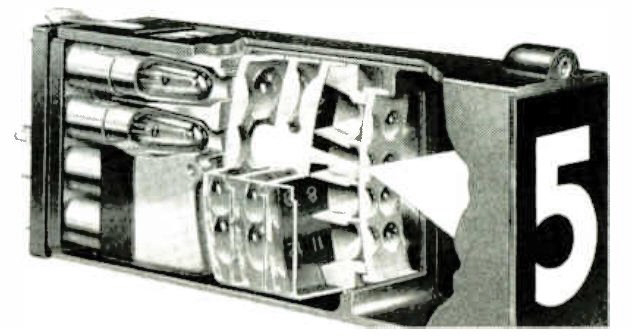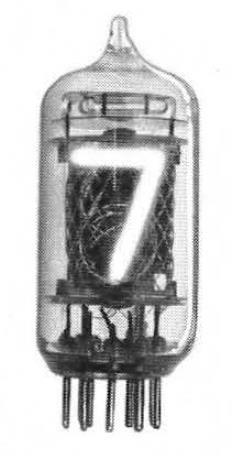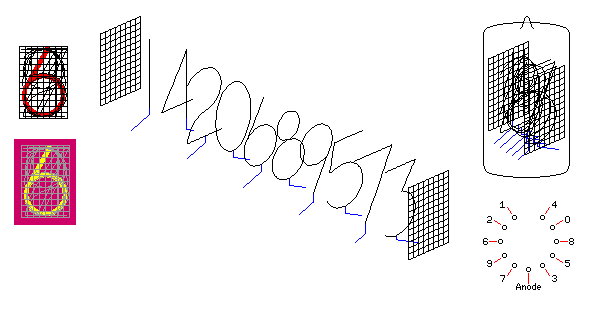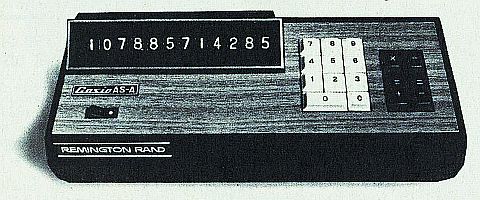
The year is 1920. You have an apparatus using that newfangled technology of electricity. You want it to display a number in some way.
One obvious choice, for displaying a single digit, would be to have ten light bulbs lined up, each one behind a window in the shape of its associated digit.
This is the kind of display one still often sees today, over the doorways of elevators.
If the light bulbs are lined up vertically, displays of this sort are even used to display multiple digits for certain types of high-speed counter.
Another option would be to paint the ten digits on flat metal plates, and using electromagnets, drop the one with the desired digit behind a window to indicate a number. This sort of apparatus is one type of "annunciator", this being a generic term for any device by which an electrical system communicates with its user; a bell or a buzzer can also be termed an annunciator as well.
As technology advanced, however, it was possible to develop faster and more compact devices for displaying digits to use with electronic computers and calculators.
One such device produced digits that looked like this:

The modules that displayed individual digits were organized as follows:
Twelve small light bulbs, similar to what you might see in a small flashlight, were organized in a 3 by 4 matrix.
Each one was partitioned off from the others in a round cell.
In front of each bulb was first a diffuser, so its light would evenly illuminate the next item: a sheet of plastic bearing the image of a digit (or perhaps a decimal point or minus sign). Further forwards was a lens, with its position and focal length so chosen that the image of that digit would be properly focused on a rear-projection screen shared by all twelve of these assemblies.
Here is a cutaway diagram of this type of display, from one of their advertisements:

This design produced a high-quality display, but it was still a bit bulky, and it was expensive.

Shown at left is the Control Data 6060 Remote Calculator, a terminal for the Control Data 6600 computer which allowed remote users to make limited use of it as a programmable calculator. This terminal used this type of display.
A far more common technology used for displaying digits in electronic devices before our modern era of liquid crystal and light-emitting diode displays was the Nixie® tube, which dates from 1955, although a 1952 patent from Northrop Aviation describes something similar. Burroughs bought a small company called the Haydu Corporation in 1955; it's not certain if they bought the company to acquire this invention, or if they bought it to provide manufacturing facilities for the indicator tube which was invented at Burroughs itself.
Apparently the Northrop invention in 1952 must have been missing something. Another company, the National Union Electric Corporation, also came up with a similar tube, the Inditron, in 1955; patent litigation between them and Burroughs was resolved in their favor
From its origin in 1955, it quickly became the most common method of displaying numbers on advanced electronic and computing devices until it was finally displaced by the seven-segment LED. The first such display that was commercially available dates from 1969, and was made by Hewlett-Packard.
Burroughs was not the only manufacturer of this kind of numeric indicator, as other manufacturers were licensed, and this kind of tube remained popular long enough that the patents expired while it was still useful.
Electrodes in the shape of digits were placed one behind the other, in a tube filled with neon gas, and the electrode which was charged glowed, making the desired digit visible.

I've finally found a picture I can use of this kind of tube:
However, it is not a picture of a genuine Burroughs® NIXIE® tube, but instead it is of a Datavue® tube by Raytheon®. Of course, in real life, no digit will glow when the tube's pins aren't connected to anything, but that is a bit of artistic license so that the advertisement will get the message of the tube's purpose across.
Here is a diagram that illustrates, to a limited extent, how this works:

On the right is an exploded view of how the elements are arranged; a grid anode in the back, with cathodes in the shape of the ten digits, one after the other, in front of it, and then another grid anode in the front.
On the left is a diagram attempting to illustrate how digits remain visible in all that jumble of wires; the cathode which recieves current makes the surrounding neon gas glow for some distance around it, so the digit to be displayed is built from a line much thicker than the wires in front of it that obscure the view.
The top diagram did not allow the digit, a 6, being displayed to be all that clearly visible, so I produced the more reasonable diagram below, showing the effect of putting a red filter in front of the tubes to increase contrast; even that left the digit poorly visible, so I obtained a further improvement by giving the wires a grey color, reflecting the fact that they had a silvery metallic color, rather than being black, and that seems to have done the trick.
In real life, the digits were not as poorly visible as the diagram tended to suggest; the limited scale of the diagram meant that lines one pixel wide, representing the wires used, were still thicker than those wires really were.
I had known of some electronic calculators which used small-sized tubes of the same type as Nixie tubes, but these still plugged into an outlet: the Casio 121a (or AS-A) and 252 calculators, one of which was also known as the Remington 1211 calculator, also sold as the Commodore 256 or Commodore 512. The tubes they used to indicate numbers were the Hitachi CD-71 display tubes.
One site gives the diameter of these tubes as 13mm, which makes them considerably larger than I thought they were. However, it is consistent with a display of twelve digits being about half as wide as the total width, thirteen inches, of the calculator itself.
Here is a photograph, from an advertisement, of one version of this calculator, sold as a Casio product, but also with a Remington label, as they were its distributor, as offered in Australia:

I had not thought that anyone had ever made a pocket calculator with a Nixie tube display, but I have recently discovered that there were at least two: the Smith Corona Marchant "Marchant I" calculator, and the Minolta Minolcom. Those, however, used larger-sized Nixie tubes than the ones previously discussed.
Amazingly, both of them had rechargeable batteries. The Marchant I had a small battery charge meter located next to the on-off switch on the upper right of the calculator... this is not unreasonable, as I'm sure the battery life of a calculator with a Nixie tube display would be terrible.